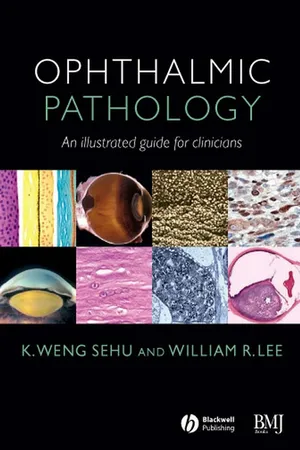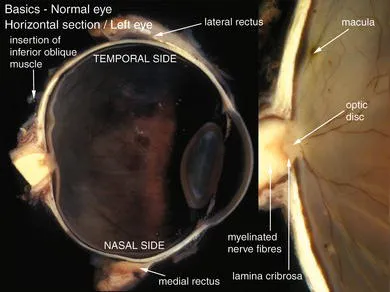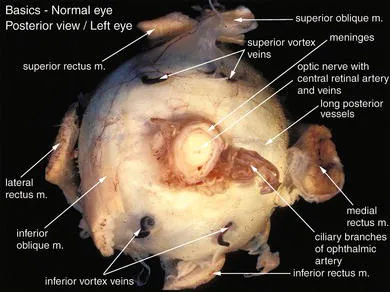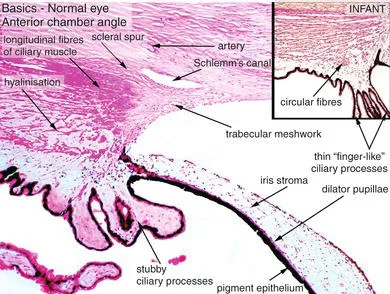
This is a test
- English
- ePUB (mobile friendly)
- Available on iOS & Android
eBook - ePub
Book details
Book preview
Table of contents
Citations
About This Book
Highly Commended at the Society of Authors and Royal Society of Medicine Medical Book Awards 2006
This outstanding atlas of ophthalmic pathology brings together the world famous collection of digital images from the Tennant Eye Institute in Glasgow.
Weng Sehu and William Lee have produced a unique body of information, moulding Ophthalmic Pathology and the accompanying interactive CD-Rom into the essential 'must-have' revision aid and reference book for ophthalmologists in training, teachers and clinical ophthalmologists worldwide.
Ophthalmic Pathology is a concise, yet informative, user friendly textbook whose unparalleled image collection will more than meet the expectations of the ophthalmological community.
Frequently asked questions
At the moment all of our mobile-responsive ePub books are available to download via the app. Most of our PDFs are also available to download and we're working on making the final remaining ones downloadable now. Learn more here.
Both plans give you full access to the library and all of Perlego’s features. The only differences are the price and subscription period: With the annual plan you’ll save around 30% compared to 12 months on the monthly plan.
We are an online textbook subscription service, where you can get access to an entire online library for less than the price of a single book per month. With over 1 million books across 1000+ topics, we’ve got you covered! Learn more here.
Look out for the read-aloud symbol on your next book to see if you can listen to it. The read-aloud tool reads text aloud for you, highlighting the text as it is being read. You can pause it, speed it up and slow it down. Learn more here.
Yes, you can access Ophthalmic Pathology by K. Weng Sehu, William R. Lee in PDF and/or ePUB format, as well as other popular books in Medicine & Opthalmology & Optometry. We have over one million books available in our catalogue for you to explore.
Information
Chapter 1
Basics
In order to achieve a better understanding of disease processes occurring in different regions of the eye, this section describes the technology currently employed by the histopathologist in the examination of tissue specimens referred by ophthalmologists. It is important to be aware of the range of laboratory services locally available. When there is a suspicion of infection, the relevant specialist (bacteriologist/mycologist/virologist) should be consulted for advice concerning appropriate transport media and therapy. The value of an accurate and concise history cannot be overestimated and good collaboration will be rewarding to both clinicians and laboratory specialists.
Examination of the enucleated eye
A formalin-fixed enucleated globe bears little resemblance to the in vivo appearance due to opacification of the cornea, lens, vitreous, and retina. Previous intervention, for example removal of keratoplasty tissue, can produce secondary damage to the anterior segment tissues (Figure 1.1). In routine practice, it is unwise to try to cut across the lens because this produces damage to the anterior segment but occasionally a suitable illustration can be provided (Figure 1.2). By dividing the globe in the coronal plane, the pathologist has the advantage of examination of the lens and ciliary body from the posterior aspect (Figure 1.3) and the retina from the anterior aspect (Figure 1.4). For demonstration purposes, it is possible to divide the optic nerve and the lens (Figure 1.5). In general, the globe is divided above the optic nerve and at the edge of the cornea to avoid traumatic artefact to the main axial structures. After paraffin processing, the microtomist cuts into the centre of the eye. The orientation of the extraocular muscles on the posterior aspect of the globe allows the pathologist to identify the side from which the globe was enucleated (Figure 1.6). Orientation of the specimen is vital if the correct plane of cut is to be made.
Microscopic features
These are described wherever relevant to pathology in the corresponding chapters and are therefore only illustrated briefly in this chapter. The histological features of each of the following tissues are annotated in detail:
- cornea (Figure 1.7)
- chamber angle (Figure 1.8)
- iris (Figures 1.8, 1.9)
- ciliary body (Figures 1.8, 1.10, 1.11)
- lens (Figures 1.9, 1.11)
- retina and choroid (Figure 1.12)
- optic disc (Figure 1.13).
Features for identification of the age of a patient (in this case a child):
- thin Descemet’s membrane
- “finger-like ciliary processes”
- intact, non-hyalinised ciliary muscle
- absence of proliferations in the pars plana epithelium
- absence of sub-RPE (retinal pigment epithelium) deposits (for example drusen).
Figure 1.1 In the current litigious climate, the only normal autopsy material available for study will be that used for donor keratoplasty. In this example, formalin fixation accounts for opacification in the cornea and lens. Damage to the iris is the result of the trephine.

Figure 1.2 The anatomical features of the anterior segment are easily recognised. Note that formalin fixation leads to opacification of those tissues (cornea, lens, zonules, and vitreous) which are normally transparent.

Figure 1.3 Dividing the eye in the coronal plane provides the opportunity to examine the ciliary body and lens in detail. In this case, there is a subcapsular cataract. The radial linear opacities in the lens substance are a common degenerative feature in the elderly globe. Note that in the pars plicata, there are ridges and troughs which explain the differing appearance of the ciliary processes in Figures 1.10 and 1.11.

Figure 1.4 In a globe removed at autopsy, there is often autolytic swelling of the macula due to delayed fixation. The opacification of the retina is the result of formalin fixation. After cessation of blood flow, the blood columns in the vessels tend to fragment (“cattle-trucking”).

Figure 1.5 This normal globe is part of an exenteration and is fixed in gluteraldehyde. For demonstration purposes, the section passes through the centre of the optic nerve, the lens, and the pupil (left). The macula is located on the temporal side of the optic nerve, which is confirmed by the adjacent scleral insertion of the inferior oblique muscle. The distance from the optic nerve to the ora is greater on the temporal side than on the nasal side. A higher magnification of the posterior pole of the globe is shown on the right. Myelination of the axons in the optic nerve ends at the lamina cribrosa.

Figure 1.6 The orientation of the extraocular muscles in relation to the optic nerve reveals that this specimen is a left globe.

Figure 1.7 A full thickness section of the cornea (left) demonstrates the relative thinness of the epithelium and endothelium in relation to the stroma. Both cell layers are shown in higher magnification (upper right and lower right). Note the artefactual separation of the corneal lamellae.

Figure 1.8 Hyalinisation and atrophy of the circular and oblique components of the ciliary muscle is a feature of ageing, but the longitudinal fibres inserting into the scleral spur persist. In an infant (inset), the components of the ciliary muscle are intact: note the thin ciliary processes.

Figure 1.9 In the pupillary portion of the iris, the sphincter pupillae is a prominent feature and the close relationship to the lens provides the opportunity to illustrate the anterior capsule and the epithelium of lens. The iris pigment epithelium t...
Table of contents
- Cover
- Title page
- Copyright page
- Preface
- Acknowledgements
- Chapter 1: Basics
- Chapter 2: Eyelid and lacrimal sac
- Chapter 3: Conjunctiva
- Chapter 4: Cornea
- Chapter 5: Orbit and optic nerve
- Chapter 6: Development and malformation
- Chapter 7: Glaucoma
- Chapter 8: Inflammation
- Chapter 9: Wound healing and trauma
- Chapter 10: Retina: vascular diseases degenerations and dystrophies
- Chapter 11: Intraocular tumours
- Index
- Download Images